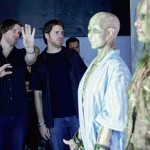Daybreakers: true [Aussie] blood
 Australian horror gets a fresh transfusion with the release of Daybreakers, a big budget film designed with a global audience firmly in mind. Paul Hayes writes.
Australian horror gets a fresh transfusion with the release of Daybreakers, a big budget film designed with a global audience firmly in mind. Paul Hayes writes.
Futuristic vampire films are not the most popular genre among Australian filmmakers, but twins Michael and Peter Spierig are not your typical directors either.
The Spierigs found international success with their first film, the self-funded ‘credit card’ zombie flick, Undead. It showed Hollywood what they were capable of, and made it possible for their second outing Daybreakers to have a cast that includes Ethan Hawke and Willem Dafoe, and the backing of US studio Lionsgate for development, production and international distribution.
The film is set in a not-too-distant future where a plague has turned 95 percent of the world’s population into vampires whose food source, human blood, is running out. Environmental allegories aside, Daybreakers is a designed to get lots and lots of paying customers into the multiplex.

